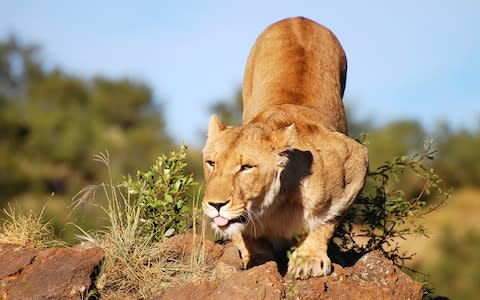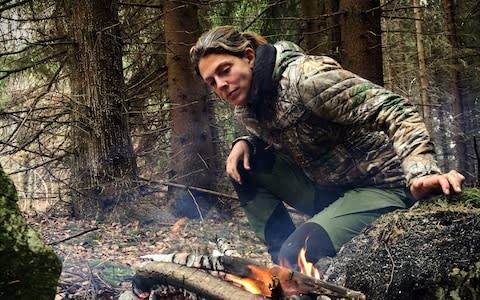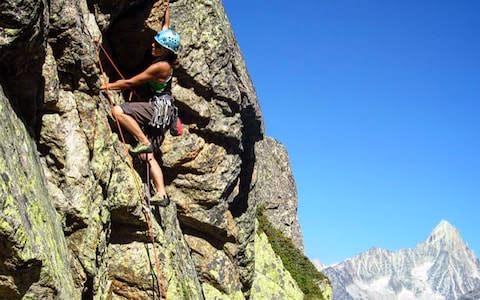Meet the female survival expert behind some of the most macho men on TV

Survival, as in fending for oneself in the wild, has normally been portrayed in the media as the preserve of men. Even though there have always been daring female explorers, such as Freya Stark and Gertrude Bell, society has wrongly dictated for a long time that adventure travel is a predominantly male activity. In recent years, however, unexpected female heroes have emerged.
I have led hundreds of expeditions across the globe, from mountain trips to anthropological-based survival excursions. I have looked after the safety of people from many walks of life. I currently spend 11 months of the year scouting locations in various remote destinations: from the Amazon and the Kalahari to the Himalayas and the Arctic Circle.

Once locations have been found, I undertake safety and survival consultancy for some of the biggest adventure shows on television, such as Bear Grylls’ Man vs Wild, Running Wild and I Shouldn’t Be Alive. I have been dropped off at destinations by myself or with contributors for weeks on end with nothing but the clothes on my back, a medical pack and an axe or a machete.
Life-and-death situations are hazards of the job. In Namibia, I was stalked by lions while working as an on-screen survival guide for a television show. As my eyes focused on the darkness beyond the small circle of firelight, I saw a large male lion silhouetted against the expanse of the Kalahari Desert sky. Desperately battling the urge to spring up and run, I sat up slowly and in a low voice, woke my companion up. Keeping my voice as calm as I could, I urged him to sit up slowly and aid me in building up the fire while keeping the huge predator in line of sight.
As the fire blazed, we noticed two lionesses join the male. We were close enough to see the lean muscles that rippled across their lithe bodies. As the lions paraded back and forth, I remember reflecting on the fact that preparation in these scenarios is key. We had gathered a pile of brushwood to see us through the night. Had we not, we would have not had any defence against these large predators. We spent the rest of the night back-to-back either side of the fire, knives out, ready to defend ourselves, knowing we wouldn’t stand a chance should the cats attack.

For days, we lived off what we could find in the desert, becoming adept at catching insects and small lizards, our staple diet. A few times, we managed to catch snakes, which provided a much-needed protein source. The body can survive for three weeks without food and I always find the first three days the hardest. Our nights were spent scraping a dent in the sand and building a fire for warmth. The temperatures climbed to nearly 104F (40C) during the day and the nights were bitterly cold.
On another film job in Kenya, I was caught in the crossfire as a local tribe, whose herd of goats had been stolen by another tribe, chased the thieves down. A ranger platoon laid an ambush directly above the gorge I was climbing. As I secured the rope to the rock, a volley of gunfire erupted around me.

As the familiar feeling of adrenalin hit, I went into default mode, pushing aside the feeling of panic. I assumed I was the target. After what felt like several minutes, the gunfire changed direction and this gave me an opening to get to the other side of the gorge. I legged it as fast as I could, sliding down the sheer sides and running through the river below – a river that housed crocodiles, which had taken a couple of locals a few days before. Climbing the other side as fast as my wet feet and hands could pull me up, I slid into a cave.
The firefight was now all around me and rounds ricocheted off the roof of the cave. It was evident that I was not the target. I managed to escape downstream and return to the Land Cruiser parked in the bush. The lesson was clear: expect the unexpected, be aware of the environment around you, consider possible escape routes and control your emotions.

I have been in various other life-and-death situations: stalked by bears in Romania, hunted by a drug cartel in Mexico, bitten by a snake in the US, caught in an avalanche in the French Alps. I believe that resilience and the ability to survive stems from exposure to different experiences and learning from successes and failures.
We are tribal creatures, designed to live as communities and to help each other out. Experiencing hardship together and working as a team to better your standing and survival chances brings people together. I see this with groups of women on expeditions, whether it be to the summit of Kilimanjaro or to explore the underworld of the jungle caves in Vietnam. Often the female clients I guide are high-flying, powerful women working in corporate environments. From the outside, they have everything. But often, they have worked so hard and overcome so many hurdles to get to where they are that they haven’t had a chance to look around them and enjoy where they are.

I have also worked with celebrities, including Kate Winslet in the Welsh mountains and Julia Roberts in Kenya, setting up rope challenges for them, such as rappels and bridge crossing. The sense of achievement after rappelling 300ft down a rock wall and overcoming your fear is powerful – no matter who you are.
The benefits of adventure travel for empowering women are obvious, but I do understand that this route is not accessible to all. If you’re looking for ways to step outside your comfort zone closer to home, have a look at bushcraft courses or indoor climbing venues. Many climbing walls run instructor-led sessions that will teach you the basics and allow you to meet other like-minded individuals.

There are also sites nationwide, run by the Forestry Commission (forestry.gov.uk), where you can hire a bike and explore a network of well-marked, purpose-made mountain cycle trails of different grades of difficulty.
Megan Hine’s book Mind of a Survivor is out now (Coronet; £18.99). The paperback version (£9.99) will be available next month.
Interview by Sarah Baxter

